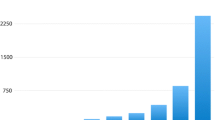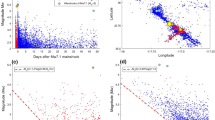Abstract
The following steps are suggested for smoothing the occurrence patterns in a clustered space–time process, in particular the data from an earthquake catalogue. First, the original data is fitted by a temporal version of the ETAS model, and the occurrence times are transformed by using the cumulative form of the fitted ETAS model. Then the transformed data (transformed times and original locations) is smoothed by a space–time kernel with bandwidth obtained by optimizing a naive likelihood cross-validation. Finally, the estimated intensity for the original data is obtained by back-transforming the estimated intensity for the transformed data. This technique is used to estimate the intensity for earthquake occurrence data for associated with complex sequences of events off the East Coast of Tohoku district, northern Japan. The intensity so obtained is compared to the conditional intensity estimated from a full space–time ETAS model for the same data.
Similar content being viewed by others
References
Abe K. (1977) Tectonic implications of the large Shioya-Oki earthquakes of 1938. Tectonophysics 41: 269–289
Adelfio G., Chiodi M., De Luca L., Luzio D., Vitale M. (2006) Southern-tyrrhenian seismicity in space–time-magnitude domain. Annals of Geophysics 49(6): 1139–1151
Akaike H. (1974) A new look at the statistical model identification. IEEE Transactions on Automatic Control AC–19: 716–723
Akaike H. (1998) A new look at the bayes procedure. Biometrika 65: 53–59
Akaike H., Parzen E., Tanabe K., Kitagawa G. (1998) Selected papers of Hirotugu Akaike. Springer, Berlin
Choi E., Hall P. (1999) Nonparametric approach to analysis of space–time data on earthquake occurrences. Journal of Computational and Graphical Statistics 8(4): 733–748
Daley D.J., Vere-Jones D. (2003) An introduction to the theory of point processes (2nd ed.). Springer, New York
Dziewonski A., Chou T., Woodhouse J. (1981) Determination of earthquake source parameters from waveform data for studies of global and regional seismicity. Journal of Geophysical Research 86: 2825–2852
Grillenzoni C. (2005) Non-parametric smoothing of spatio-temporal point processes. Journal of Statistical Planning and Inference 128(1): 61–78. doi:10.1016/j.jspi.2003.09.030
Hawkes A. (1971) Spectra of some self-exciting and mutually exciting point processes. Biometrika 58(1): 83–90
Hawkes A., Adamopoulos L. (1973) Cluster models for erthquakes-regional comparison. Bulletin of the International Statistical Institute 45(3): 454–461
Kanamori H. (1971) Seismological evidence for a lithospheric normal faulting–the sanriku earthquake of 1933. Physics of the Earth and Planetary Interiors 4: 289–300
Ogata Y. (1988) Statistical models for earthquake occurrences and residual analysis for point processes. Journal of the American Statistical Association 83(401): 9–27
Ogata Y. (1998) Space–time point-process models for earthquake occurrences. Annals of the Institute of Statistical Mathematics 50(2): 379–402
Ogata Y. (2004) Space–time model for regional seismicity and detection of crustal stress changes. Journal of Geophysical Research 109: B03308. doi:10.1029/2003JB002621
Ogata Y. (2007) Seismicity and geodetic anomalies in a wide area preceding the Niigata-ken-Chuetsu earthquake of 23 October 2004, central japan. Journal of Geophysical Research 112: B10301. doi:10.1029/2006JB004697
Ogata Y., Katsura K. (1988) Likelihood analysis of spatial inhomogenity for marked point patterns. Annals of the Institute of Statistical Mathematics 40(1): 29–39
Ogata Y., Zhuang J. (2006) Space–time ETAS model and an improved extension. Tectonophysics 413: 13–23
Ogata Y., Katsura K., Tanemura M. (2003) Modelling heterogeneous space–time occurrences of earthquakes and its residual analysis. Applied Statistics 52(4): 499–509
Schoenberg F.P. (2003) Multi-dimensional residual analysis of point process models for earthquake occurrences. Journal of the American Statistical Association 98(464): 789–795
Silverman B.W. (1986) Density estimation for statistics and data analysis. Chapman and Hall, London
Utsu T. (1961) A statistical study on the occurrence of aftershocks. Geophysical Magazine 30: 521–605
Utsu T. (1970) Aftershocks and earthquake statistics (ii): Further investigation of aftershocks and other earthquake sequences based on a new classification of earthquake sequences. Journal of the Faculty of Science, Hokkaido University, Series VII (geophysics) 3: 198–266
Utsu T., Seki A. (1955) Relation between the area of aftershock region and the energy of the main shock (in japanese). Zisin (Jouirnal of the Seismological Society of Japan), 2nd Series, ii 7: 233–240
Utsu T., Ogata Y., Matsu’ura R. (1995) The centenary of the omori formula for a decay law of aftershock activity. Journal of Physics of the Earth 43: 1–33
Author information
Authors and Affiliations
Corresponding author
About this article
Cite this article
Adelfio, G., Ogata, Y. Hybrid kernel estimates of space–time earthquake occurrence rates using the epidemic-type aftershock sequence model. Ann Inst Stat Math 62, 127–143 (2010). https://doi.org/10.1007/s10463-009-0268-7
Received:
Revised:
Published:
Issue Date:
DOI: https://doi.org/10.1007/s10463-009-0268-7




